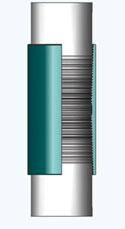Casing Drilling Technology
Casing Drilling: How the pieces fit
Companies throughout the industry provide components crucial to the time-saving casing drilling process
By Alexandra Pruner, Gulf Publishing Company
Casing drilling permits operators to simultaneously drill, case and evaluate oil and gas wells, thereby significantly reducing drilling time and the potential for unscheduled events. Field studies have demonstrated a 20 – 30% reduction in the time required to drill wells from spud to rig release when utilizing this method. Both onshore and offshore, casing drilling has been demonstrated to improve reservoir productivity. It also simplifies well architecture in deepwater applications by minimizing formation damage and the cost of well construction and intervention.
Tesco Corporation and Weatherford both have patented systems for this breakthrough drilling method, and a number of other leading companies provide connections, tubing, drill bits and other components crucial to the process.
Drilling with tubing, a precursor to drilling with casing, has been used for years in well repair. PEMEX, for instance, utilized 3-1/2 -in. production tubing with Antartes PJD connections (Tenaris) in its Caparrosso field. The tubing was successfully subjected to tensile, compression, external and internal pressure and torque stress for more than 11 days of effective rotation. Drilling with tubing oftentimes entails cementing the tubing – and BHAs – in place.
In Tesco’s proprietary casing drilling process, downhole tools can be retrieved, through the casing on wire-line, meaning tool recovery or replacement of tools can take minutes versus hours under conventional methods. This process employs wireline-retrievable tools and a drill-lock assembly, permitting bit and BHA changes, coring, electric logging and even directional or horizontal drilling.
Weatherford, whose patented drilling with casing system has been used principally in the offshore, employs a system where the drillshoe is attached to the casing, and the casing is rotated by the top drive using an internal quick-connect gripping tool. Once TD has been reached, the drillshoe design allows for cementing operations to begin almost immediately. After cementing is completed, a BHA with a PDC bit drills through the shoe. In the case of Weatherford’s third-generation shoe, the hard-formation cutting structure is displaced into the annulus by a simple pressure cycle. The next BHA can then drill the remaining hole section.
Hughes Christensen provides disposable and other application-specific drill bits for casing drilling. Baker Hughes’ INTEQ offers drilling BHAs for surface hole and reentry, incorporating high performance motors and MWD/LWD systems.
Given the rigors of concurrently casing while drilling, the tubular connections used in the process must provide high resistance to cyclic-torsion loads, sealing capability that overcomes dramatic cyclic loads and significant fatigue resistance. To fulfill these requirements, while also providing a field-friendly design for running procedures, Grant Prideco developed a coupled connection (DWC/C) that was based on an API buttress design and modified to provide torque strength and fatigue resistance.
 |
| Grant Prideco’s DWC/C connection has been used successfully in casing drilling operations in Wyoming and South Texas. |
|
Hunting Energy Services’ premium connection, used by Tesco in select drilling activities in Canada and the US, is the Hunting Buttress KC convertible connection – a close tolerance API-based buttress threaded and coupled connection with a steel ring inserted in the “J” area. The steel ring greatly increases the connection’s torque capacity and stabilizes the connection for bending and fatigue resistance.
Recognizing that operators must offset the cost of an optimum connection with the benefit of product features, such as torque strength, clearance and fatigue strength, Hydril offers its Series 500 Wedge Thread Casing connections.
Although standard rigs can be modified to accommodate casing while drilling, Tesco has built rigs specifically for this purpose. The company recently announced that PEMEX is using casing drilling for a 10-well program in the Burgos and Poza Rica fields in Northern Mexico. Drillers Technology Rig No. 4, which had recently been released from the Lobo field in South Texas, will do the work. This rig is one of three in their Genesis Series.
One of the most meaningful benefits of casing drilling is the reduction of downhole trouble time. By concurrently casing while drilling, lost circulation and well control incidents have been nearly eliminated thereby enhancing safety. This is particularly key for wells that encounter a weak zone prior to drilling into a higher-pressure zone. Balancing the required procedures for these differing zones has historically been a challenge that can be overcome through casing drilling. 
Ms. Pruner oversaw Gulf Publishing Company’s March 2003 technical conference on Casing Drilling. Additional information can be found at www.worldoil.com/conference.
|



